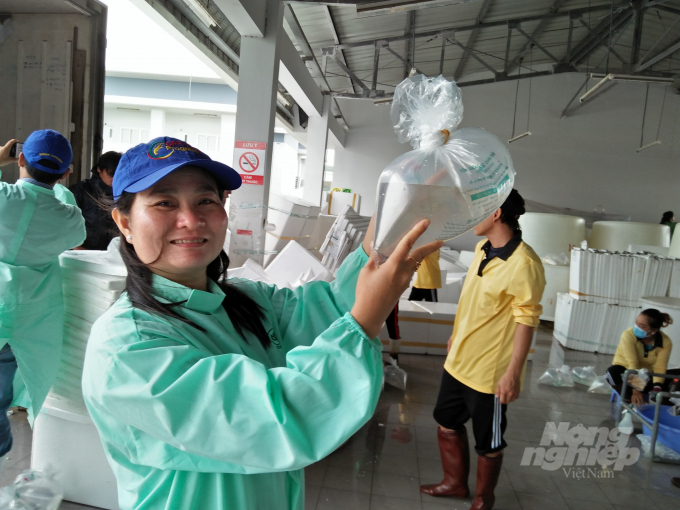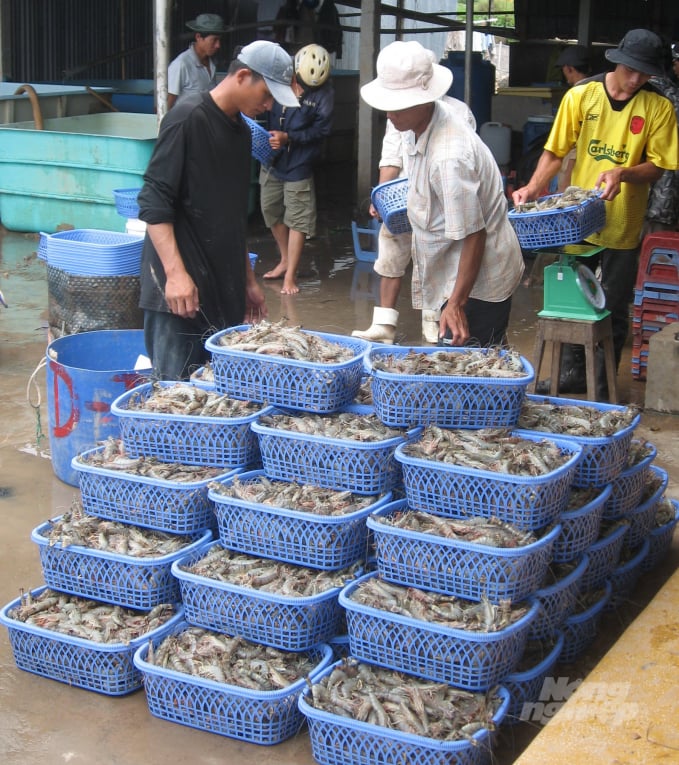November 28, 2025 | 06:42 GMT +7
November 28, 2025 | 06:42 GMT +7
Hotline: 0913.378.918
November 28, 2025 | 06:42 GMT +7
Hotline: 0913.378.918

Vietnam's shrimp export industry has great potential for development. Photo: Huu Duc.
By 2022, the market is predicted to provide a variety of favorable opportunities for the Vietnamese shrimp industry. The conflict between Russia and Ukraine has hampered the oil, petroleum, and agricultural industries. As a result, the prices of fertilizer, animal, and aqua feeds fluctuate causing the rising cost of production.
After several years of significant advancements in the application of new techniques and improved shrimp farming technology, the shrimp business has continued to flourish, adding to the agriculture industry's export achievement chain. However, there are still obstacles and limits placed by the farming area. Thus, what are the obstacles to overcome?
The Directorate of Fisheries held a meeting in Soc Trang on March 11 to discuss solutions for developing the shrimp business in 2022 and to sign a regulation on cooperation in the management of brackish water shrimp breeds in 2022.
MARD Deputy Minister Phung Duc Tien presided and assessed the situation, which revealed that despite a challenging 2021, shrimp farming and production outcomes last year met or exceeded goals. The country's shrimp exports were USD 3.9 billion, up 5.4 percent year on year. The shrimp sector, on the other hand, must recognize that the price of farmed shrimp remains high. There has been no investment in infrastructure or irrigation construction. Although the area available for extensive shrimp farming remains large, shrimp farming technology, particularly extensive shrimp farming, remains ineffective.
According to a field study conducted in shrimp farming sites around the localities, there are still certain issues and problems. Shrimp seeds and breeds are highly dependent on their import source. Domestic exploitation of nature can only give a portion of the solution while farmers remain passive producers. Costs of shrimp production remain greater than in other nations in the area. The reason for this is that shrimp feed continues to account for a sizable amount of commercial shrimp growing costs (about 65 percent), and seed is expensive. The majority of infrastructure in the farming area is inadequate.

Closely inspect and improve shrimp seed production capacity. Photo: Huu Duc.
In 2022, the shrimp export industry is predicted to show encouraging signs. According to Mr. Truong Dinh Hoe, general secretary of the Vietnam Association of Seafood Exporters and Producers (VASEP), there were over 500 Vietnamese enterprises selling shrimp to 103 markets globally in 2021, with 97 percent of export revenue concentrated in eight major market segments. By 2022, the US is anticipated to remain to be Vietnam's leading shrimp importer. Vietnam's shrimp exports to the US are expected to expand due to the recovery of the HORECA chain and the strength of processed shrimp.
While Europe's trend toward food stockpiling may increase import demand, Japan remains a significant and traditional market for Vietnam's shrimp business, accounting for 15% of total shrimp export value in recent years. With the export results for the first two months of 2022, demand from the Japanese market began to recover, with Vietnamese shrimp producers being the market's preferred supplier.
The main markets, with the exception of China, are projected to restore their demand in the next months. On the other side, inflation is expected to raise manufacturing costs, selling prices, and slow order growth. The Russian-Ukrainian conflict has a considerable influence on logistical costs and operations, posing a significant obstacle to shrimp export development. Thus, while shrimp materials are sufficient for processing, prices will grow further in 2022 due to complicated fluctuations in input factors.
At the conference on the predicted problems in 2022, Deputy Minister Phung Duc Tien recognized thoughts and opinions from responsible ministry departments and local authorities. As a result, agricultural production activities, such as the shrimp business, require adaptable solutions in order to overcome obstacles. Shrimp aquaculture is limited by the lack of infrastructure, environmental pollution, diseases, input materials (aquatic feed), chemical supply, and logistics. The Covid-19 outbreak condition also has an effect on the industrial chain.
However, there are opportunities arising from the hardship; the Deputy Minister emphasized the shrimp industry's enormous potential. According to VASEP, the shrimp sector will grow by 57% in value and 24% in volume by 2022.
To begin, the industry should analyze the components necessary to enhance its competitive capability, both in terms of value and volume. Seeds must be monitored and managed, while seed production capacity must be enhanced. Second, it is critical to research input materials to reduce feed costs. Third, more effective disease monitoring, warning, and management to improve the quality of farmed shrimp. Simultaneously, linking to develop into new markets and having more export shrimp goods fulfill the market's stringent specifications.
According to the Directorate of Fisheries, brackish water shrimp farming would cover more than 747,000 hectares in 2021, with 626,000 hectares given to black tiger shrimp and 121,000 hectares to white leg shrimp. Shrimp output was 970,000 tons, an increase of 4.3 percent over the same time in 2020.
According to VASEP, Vietnam's shrimp exports are predicted to increase by 10%-12% in 2022. Exports surpassed USD 4 billion.
Translated by Linh Linh

(VAN) On November 27, in the meeting with Minister Tran Duc Thang, Mayor Yin Yong shared Beijing’s experience to improve environment and air quality.

(VAN) After 30 years, both sides identified strategic areas of cooperation: sustainable production, increasing coffee value and training for farmers.
/2025/11/27/4910-4-164708_294.jpg)
(VAN) On the afternoon of November 27 in Beijing, Minister of Agriculture and Environment Tran Duc Thang held a working session with several major Chinese enterprises operating in the agriculture and environment sector.

(VAN) The Department of Animal Health issued a provisional guideline requesting local authorities to increase surveillance, collect samples for testing, and conduct epidemiological investigations according to the established procedure.

(VAN) The United Nations recommends that Vietnam utilize data and artificial intelligence to enhance early disaster warnings and reduce GDP losses by 3.2% in the context of climate change.

(VAN) On the morning of November 27 in Beijing, Minister Tran Duc Thang and the Deputy Commissioner General of the General Administration of Customs of China signed a protocol on fresh jackfruit exports.

(VAN) As floodwaters recede, a vast network of irrigation works across eastern Gia Lai is emerging in a state of severe disrepair, with extensive damage demanding urgent restoration ahead of the 2025-2026 winter-spring cropping season.